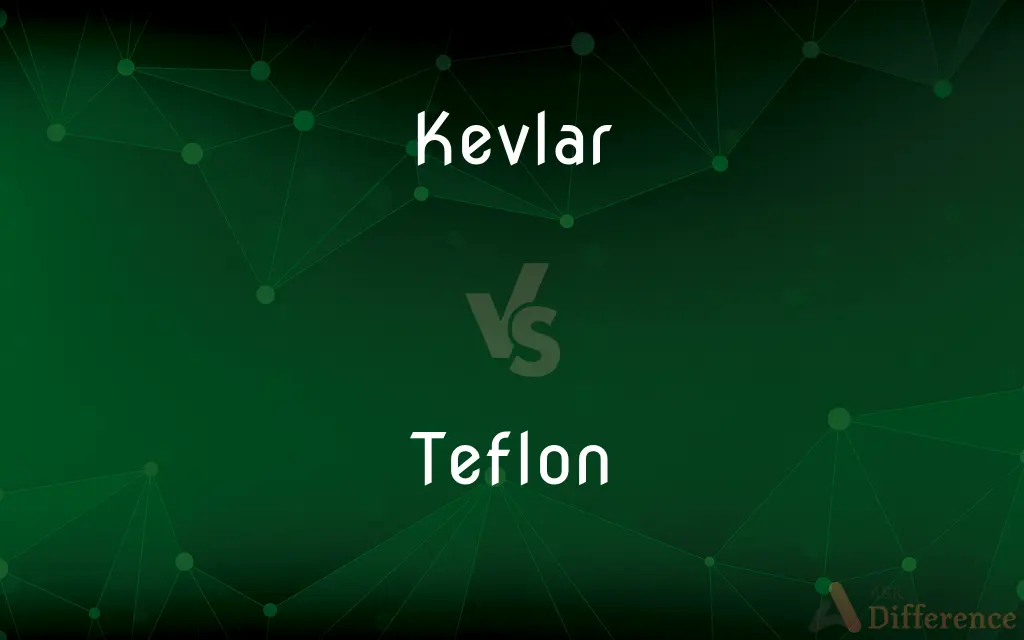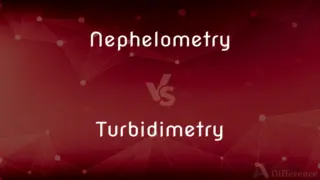Kevlar vs. Teflon — What's the Difference?
Edited by Tayyaba Rehman — By Urooj Arif — Updated on March 5, 2024
Kevlar is a high-strength, heat-resistant synthetic fiber used for impact-resistant materials. Teflon, known for its non-stick properties, is a brand name for PTFE, used in cookware coatings and as a lubricant.

Difference Between Kevlar and Teflon
Table of Contents
ADVERTISEMENT
Key Differences
Kevlar, a para-aramid synthetic fiber, is renowned for its high tensile strength-to-weight ratio, making it five times stronger than steel on an equal weight basis. Its applications extend beyond personal and military protective gear to include vehicle armor, sports equipment, and even in the construction of rope and cable. Teflon, on the other hand, is the trade name for polytetrafluoroethylene (PTFE), a synthetic fluoropolymer of tetrafluoroethylene. Its most famous attribute is its non-stick property, which has revolutionized the culinary industry by allowing food to cook without sticking to pans.
Kevlar's ability to withstand high temperatures without losing its structural integrity makes it valuable in environments exposed to extreme heat. Beyond cookware, Teflon's chemical and thermal resistance make it ideal for a variety of industrial applications, including in aerospace for protective coatings and as insulation for wiring.
The key distinction between Kevlar and Teflon lies in their primary properties and uses: Kevlar is sought after for its durability and protective qualities, especially in terms of impact resistance and thermal stability, while Teflon is prized for its ability to reduce friction and resist chemical and temperature-related degradation. While both are synthetic and offer high performance in their respective applications, their functionalities cater to different needs—Kevlar primarily for protection and strength, and Teflon for its non-reactivity and non-stick surface.
The engineering behind Kevlar fibers focuses on the material's ability to absorb energy and resist breaking under tension, which is why it's a staple in safety and ballistic protection applications. Teflon’s engineering, however, concentrates on minimizing surface energy, which prevents substances from adhering to it, making it indispensable in applications where a non-stick surface is crucial.
Despite their distinct primary functions, both Kevlar and Teflon highlight the versatility and innovation within synthetic materials, demonstrating how specialized engineering can produce substances with remarkable and diverse capabilities.
ADVERTISEMENT
Comparison Chart
Composition
Para-aramid synthetic fiber
Polytetrafluoroethylene (PTFE)
Primary Property
High tensile strength, heat resistance
Non-stick, chemical and thermal resistance
Applications
Vehicle armor, ropes
Non-stick cookware, industrial coatings
Temperature Resistance
High, does not melt easily
Very high, resistant up to 260°C (500°F)
Uses
Protection and reinforcement
Cooking, lubrication, insulation
Compare with Definitions
Kevlar
A high-strength material used in vests.
The police officer's life was saved by a Kevlar vest.
Teflon
Lubricant in applications requiring minimal friction.
Teflon spray is used on squeaky hinges for smooth operation.
Kevlar
Heat-resistant fiber for extreme environments.
Firefighters' gear includes Kevlar for its heat resistance.
Teflon
Used in aerospace for heat-resistant properties.
Spacecraft utilize Teflon components to withstand re-entry temperatures.
Kevlar
Essential in making cut-resistant gloves.
Industrial workers wear Kevlar gloves to protect against cuts.
Teflon
Material for chemical-resistant seals.
Chemical processing equipment often includes Teflon seals.
Kevlar
Reinforcement in sports equipment.
Professional racing helmets are reinforced with Kevlar for extra protection.
Teflon
Insulation material for wiring in electronics.
High-end audio cables are insulated with Teflon for superior signal integrity.
Kevlar
Durable component in automotive brake pads.
High-performance cars use Kevlar brake pads for better durability.
Teflon
Non-stick coating for cookware.
Her new frying pan is coated with Teflon, making cleanup easy.
Kevlar
Kevlar (para-aramid) is a heat-resistant and strong synthetic fiber, related to other aramids such as Nomex and Technora. Developed by Stephanie Kwolek at DuPont in 1965, the high-strength material was first used commercially in the early 1970s as a replacement for steel in racing tires.
Teflon
Polytetrafluoroethylene, PTFE
Kevlar
(uncountable) (Fabric, cordage, etc made of) aramid fiber, an exceptionally strong, light, man-made fibre used to strengthen cables and sheet materials, e.g. in stab-resistant vests.
Teflon
(metaphorically) Non-stick, slick.
Kevlar
A piece of personal protective equipment made from Kevlar, such as a helmet or a vest.
Teflon
Able to easily shrug off or deflect criticism or blame.
The teflon Prime Minister
Teflon
A material used to coat cooking utensils and in industrial applications where sticking is to be avoided
Teflon
Not to be trusted;
How extraordinarily slippery a liar the camera is
They called Reagan the teflon president because mud never stuck to him
Common Curiosities
Can Kevlar be used in construction?
Yes, Kevlar's tensile strength makes it suitable for use in various construction applications, including as reinforcement in concrete and in protective gear for construction workers.
Is Kevlar use vest on its own?
Kevlar is highly resistant to penetration, making it a key component in vests, though these vests often include multiple layers and may combine with other materials for enhanced protection.
Are there environmental concerns with using Teflon?
The manufacturing process of Teflon has raised environmental concerns, particularly regarding the emissions of certain perfluorinated compounds.
Can Teflon coatings be repaired?
Once Teflon cookware is scratched or damaged, it cannot be effectively repaired to its original condition; replacement is usually the best option.
Can Teflon withstand high temperatures?
Teflon can resist temperatures up to approximately 260°C (500°F), beyond which it may begin to degrade and release harmful fumes.
Are there alternatives to Kevlar for protective gear?
Yes, there are other materials like Dyneema and Spectra that are also used in protective gear for their high strength-to-weight ratios.
How do the costs of Kevlar and Teflon compare?
The cost of Kevlar and Teflon products varies widely based on the application and quality. Generally, specialized applications of both materials, such as in protective gear or high-quality cookware, can be relatively expensive due to the technology and processing required.
How is Teflon applied to cookware?
Teflon coatings are typically applied to metal cookware through a process that includes spraying and baking the coating to adhere it to the surface.
What makes Kevlar so strong?
Kevlar's strength comes from its molecular structure, where strong bonds and parallel alignment of its molecules distribute force across the fiber, enhancing its tensile strength.
Is it safe to use scratched Teflon cookware?
Using scratched Teflon cookware can lead to the flaking of non-stick coating, which might not be harmful if ingested in small amounts but can reduce the cookware's non-stick effectiveness. It's generally recommended to replace damaged non-stick cookware.
Share Your Discovery

Previous Comparison
Nephelometry vs. Turbidimetry
Next Comparison
Paisano vs. RoadrunnerAuthor Spotlight
Written by
Urooj ArifUrooj is a skilled content writer at Ask Difference, known for her exceptional ability to simplify complex topics into engaging and informative content. With a passion for research and a flair for clear, concise writing, she consistently delivers articles that resonate with our diverse audience.
Edited by
Tayyaba RehmanTayyaba Rehman is a distinguished writer, currently serving as a primary contributor to askdifference.com. As a researcher in semantics and etymology, Tayyaba's passion for the complexity of languages and their distinctions has found a perfect home on the platform. Tayyaba delves into the intricacies of language, distinguishing between commonly confused words and phrases, thereby providing clarity for readers worldwide.













































